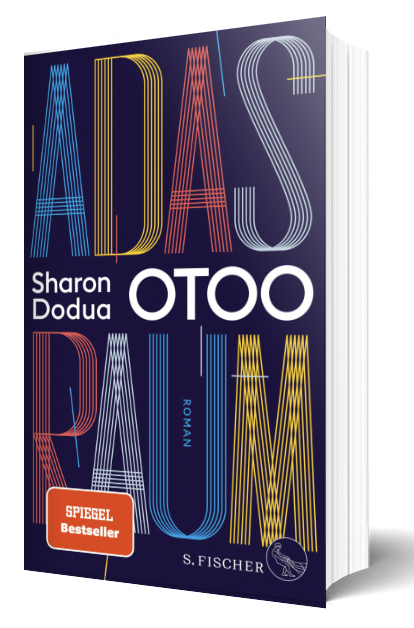
A village woman who just lost her newborn in 1459 pre-colonial Ghana, a British countess who pioneered the invention of the computer with her exceptional mathematical talents in 1848, a Polish inmate forced into prostitution in a Nazi concentration camp in 1945, and a pregnant black woman searching for an apartment in Berlin in 2019 – renowned author Sharon Dodua Otoo’s much anticipated new novel Adas Raum (Ada’s Realm) weaves together the lives of these four women, all named Ada, through gripping images of suffering, loss, friendship, and love. Like Otoo’s Ingeborg Bachmann Prize-winning short story “Herr Gröttrup setzt sich hin,” the majority of Adas Raum is told through the perspectives of inanimate objects–a broom, a doorknob, a room in a makeshift brothel, and a passport function as the main narrators for each of the four plotlines. At the same time, the text gestures towards a proliferation of objects with anthropomorphic features. Eyeglasses, the breeze, a glass of milk, and the contemporary Ada’s unborn baby, among others, all comment on the unfolding of events in their respective worlds at unexpected turns.
Constantly urging the readers to plunge into a different story while they are still attempting to register the rich blend of shocking events and intense emotions expressed in the current setting, the novel does not allow its audience to dwell on a single heroine’s life. Instead, the time travel structure of the narrative draws attention to the inextricable links between the recurring loops of physical, sexual, and ideological violence committed against the female protagonists across centuries and continents, sometimes with a dizzying effect that forestalls an immediate interpretation of the characters’ cultural milieu. The novel’s unconventional settings also uproot the author from her own places of memory. The fact that Otoo is a second-generation Ghanaian immigrant born and raised in Britain and has lived in Germany for over fifteen years allows her personal connections to each of the stories portrayed. At the same time, however, the novel’s historical settings necessitate a certain degree of distancing from the very countries and cultures with which she is familiar.
Readers of the novel have already made various attempts at deciphering the novel’s enigmatic structure. German critics have highlighted the novel’s use of Afrofuturism (see book reviews in the Frankfurter Allgemeine Zeitung and Der Standard) and animism (see book reviews in Der Tagesspiegel and Deutschlandfunk), its mixing of generic conventions of historical documentation and science fiction, as well as its affinity to postcolonial literature written by Anglophone Black women writers. The plurality of analytical discourses invoked attests to the difficulty of precisely situating Adas Raum within existing frameworks of reference. Nevertheless, Otoo herself has spoken against such interpretive gestures. During a recent book talk with translator Jon Cho-Polizzi and Deniz Göktürk (see a report of this event by Elizabeth Sun and Ardo Ali), Otoo says, “My understanding of the world isn’t so neatly categorized. My own biography cannot be neatly categorized. And I think, actually, nobody’s can, but yet we keep trying to make these very clear, neat categories to fit in. I wanted to write something that would bring the reader through an experience of directly feeling, on their own bodies, that things cannot be neatly categorized, so if anybody’s reading this novel and feeling confused, that’s the point.”
Indeed, the novel’s ingenious use of inanimate objects as narrative beings precisely echoes Otoo’s statement against classification and conventional interpretation. In her landmark essay “‘Where Have All the Natives Gone?’,” Rey Chow outlines problematic ways of interpreting the native other and proposes alternative solutions through which indigenous subjectivity might retain its integrity during an encounter with Western eyes. She argues that many scholars of postcolonialism define the native as someone from whom something has been stolen; therefore, the anti-imperialist project of subjectivizing the other almost invariably involves restoring that which has been lost, including giving back the native her voice that has been consistently silenced by the colonizer (327). However, such a definition necessarily posits the native as a desirous subject persistently envying that which she does not or no longer possess(es), thus relegating her to the lower end of the hierarchy, beneath the Western subject who is always understood as a unified whole. Resembling an Oedipal complex, this approach attempts revenge by returning the act of violence that the enemy once inflicted on the native, but in so doing, it reinstates the very ideological discourse that it aims to dismantle (Chow 334).
An alternative approach combats the construction of the native as the direct “other” of the colonizer by “add[ing] to this ‘image’ of the native the ability to look” and a gaze that “witnessed the native’s oppression prior to her becoming image,” or victim (Chow 342). “The agency of the native cannot simply be imagined in terms of a resistance against the image [of victimization] – that is, after the image has been formed…. It needs to be rethought as that which bears witness to its own demolition – in a form that is at once image and gaze, but a gaze that exceeds the moment of colonization” (Chow 342, emphasis in the original). In Otoo’s novel, this interstitial, liminal gaze stems precisely from the inanimate objects that frequently mediate between the aggressor and the victim. As a third actor observing the scene of the crime with a more or less detached attitude, the various narrating objects of the novel do not allow the perpetrator to domesticate Ada with the belittling gaze of a conqueror, while simultaneously forestalling a sentimentalization of suffering that a first-person narration by Ada herself might incur. Thus, the diverse array of inanimate objects evoked in the novel plays against the tension inherent in a binary opposition of the oppressor and the oppressed, thereby granting the female protagonists a level of subjectivity rarely seen in postcolonial novels.
Work Cited: Chow, Rey. “‘Where Have All the Natives Gone?’.” Feminist Postcolonial Theory: A Reader, edited by Reina Lewis and Sara Mills, Routledge, 2003, pp. 324-349.


